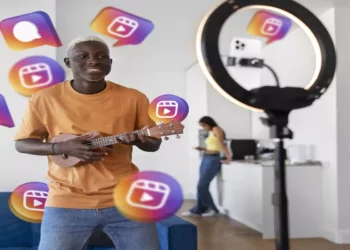Influencer marketing is an online marketing strategy which consists of collaborating with influencers (in other words people with one or more accounts on social networks, with a significant number of subscribers) to promote your brand, your products or your services to their audience. Influencers are people who often have a large following on social media and have the ability to influence the opinions and purchasing behaviors of their followers. But sometimes, appealing to influences with a smaller audience can be just as beneficial.
What is micro-influence?
Micro-influence is an influencer marketing strategy that focuses on micro-influencers, that is, people who have a small but engaged community of subscribers (or followers) on social media, often in a specific niche. Unlike macro-influencers who have millions of followers, micro-influencers typically have between 1,000 and 100,000 followers.
The micro-influence strategy aims to engage these micro-influencers to promote a product or service to their community. Due to their smaller size, micro-influencers are often perceived as more authentic and closer to their audience, which can make their promotion more effective. They also tend to have a more personal relationship with their audience and can therefore influence their followers' choices more.
Micro-influence is often used in industries such as fashion, beauty, fitness and travel, where specialist micro-influencers can have great influence over their followers. Brands can collaborate with micro-influencers by offering them free products or services or paying them for their promotion. By using micro-influence, brands can reach a targeted audience and generate higher engagement with their audience. Micro-influence is becoming popular in more and more sectors, such as cooking, automobiles, maternity, decoration, renovation etc.

A more engaged audience
Micro-influencers often have smaller audiences than larger influencers, but their followers are often more engaged and loyal. Micro-influencers often have a closer relationship with their audience and are more likely to elicit a response from them. This means that if a micro-influencer promotes your product or service, their followers are more likely to respond to their content.
A more affordable cost
Collaborating with micro-influencers can be more affordable than working with large influencers. Micro-influencers are often more affordable because they have smaller audiences, but that doesn't mean they're any less effective. Micro-influencers can help build awareness of your brand among a targeted and engaged audience, which can help drive sales and increase your brand visibility.
A targeted audience
Micro-influencers often have more specialized and targeted audiences. They have often built their audience around a specific theme, such as fitness, fashion or food. This means that if you work with a micro-influencer who is relevant to your niche, you can reach an audience more relevant to your brand. Micro-influencers can help build awareness of your brand among relevant audiences, which can help increase your brand visibility and drive sales.
Authentic content
Micro-influencers are often more authentic than large influencers. They often have a more personal voice and unique content style. Micro-influencers have often built their audience by sharing their own story and personal experience, which can help build trust with their audience. If a micro-influencer promotes your product or service, it is more likely that their content will be authentic and will be well received by their audience.

Here are some steps to follow to contact a micro-influencer:
- Identify micro-influencers relevant to your brand and target audience. You can use micro-influencer search tools or influencer marketing platforms to find profiles based on their audience size, niche, and engagement.
- Interact with influencer content by liking, commenting or sharing their publications on social networks. This can help build a relationship with the influencer and familiarize them with your brand.
- Send a private message or a personalized email to propose a collaboration with the influencer. Briefly explain what you have in mind and how it could benefit the influencer and their audience. Make sure to personalize your message based on the influencer's profile and their audience.
- Offer perks and rewards for the influencer, such as free products, discount codes for their followers, invitations to exclusive events or compensation for their promotion.
- Be transparent about your expectations and details of the collaboration, such as deadlines, promotion guidelines and compliance rules. Also be sure to follow ethical standards and advertising rules to avoid confusion among the public.
In short, to make contact with a micro-influencer, it is important to develop an authentic relationship and propose a collaboration that is mutually beneficial for both parties. Influencer marketing campaigns can take many different forms, including sponsored social media posts, sponsored blog posts, sponsored videos, product testimonials, sponsored events, and more. Brands can also work with influencer marketing agencies to find the right influencers, manage collaborations and measure results.

To conclude
Influencer marketing is increasingly popular because it allows brands to reach a targeted and engaged audience, humanize their brand and create a more authentic connection with their audience. However, it is important that brands and influencers work together ethically and transparently, making sponsored partnerships clear to avoid confusion among the public.
In conclusion, micro-influencers can be a great choice for an influencer marketing campaign. They have more engaged audiences, are more affordable, have a more targeted audience, and often create authentic content. Micro-influencers can help build awareness of your brand, whether it is already well established or about to be launched.




